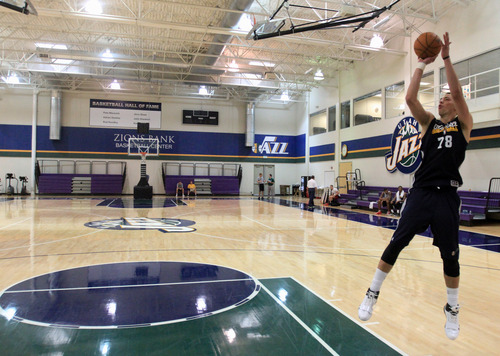This is an archived article that was published on sltrib.com in 2013, and information in the article may be outdated. It is provided only for personal research purposes and may not be reprinted.
Anyone who's dissatisfied with the Jazz's draft results Thursday should blame general manager Dennis Lindsey.
Those who like the outcome should credit Judy Adams and Cristi Bailey.
The team's executive staff members have a facilitated a monumental undertaking in advance of the NBA draft, arranging to bring roughly 70 players to town for workouts. That's a lot of logistical work, and it just might translate into a successful draft.
I'll say this: The Jazz may make the wrong choices, but they certainly have put full effort into this process.
"It's been eye-opening for me, with the number of guys we brought in," said Walt Perrin, the Jazz's vice president of player personnel. "We want to get a hands-on view of a lot of people."
They've sure done that. In the first Jazz draft I covered, the team brought in one player: Keith Lee, who ended up being taken ahead of Karl Malone in 1985. Things are different now. The Jazz are not the only team that's being more thorough now, but they've taken it to an extreme.
That's because they're uniquely positioned this year. With the Nos. 14 and 21 picks, they have to study a greater volume of players. The two picks give them the potential to move up, which means they have to cover more contingencies in scouting. The Jazz also have a second-round pick and, with a bunch of other roster spots to fill, the Jazz should have their choice of undrafted players.
All that adds up to a very busy last six weeks for the Jazz's management and scouting staff. They like being able to observe the players in scripted settings, beyond college games and practices, to see how they respond to certain situations and show expanded skills.
But first, they have to get here. "Logistically," Perrin said, "it can be a nightmare at times."
Perrin did not have to make all those flight arrangements, as Adams and Bailey did, but he did have to work with agents to put together the best workout sessions for the sake of evaluation. He tried to package players by position to create competition, and was disappointed that agents would not allow him to match Lehigh's C.J. McCollum against Syracuse's Michael Carter-Williams, for example.
He also would have liked to bring in Michigan's Trey Burke and other projected top picks, just in case the Jazz move up.
If that happens, they might have to rely strictly on old-school scouting methods.
Twitter: @tribkurt





